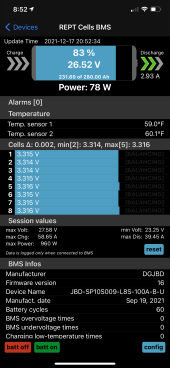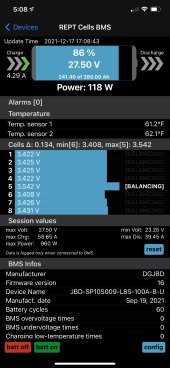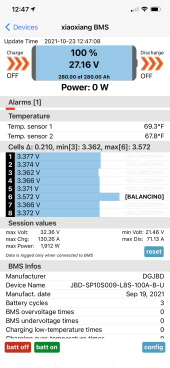brandonboosted
New Member
- Joined
- Jul 30, 2021
- Messages
- 155
My setup is 8x 280ah Eve Cells and 8x 280ah Rept cells. I am using a JBD 24v Balancer and the 2 banks are connected in parallel with even lengths of wire connecting them. I am using a victron 250/100 controller and it can see up to 100 amps with my panels but averages 40-50a currently in these winter months. I have top balanced these packs 2 times now and over time they just get completely out of whack as it gets closer to full (27.40v-28.40v) As the battery discharges the cells all balance within .10mv without a problem and that is around 26.7v per bank. Here is one bank as it sits with the charger in absorption and the cell over voltage triggered-
1. 3.432v
2. 3.417v
3. 3.471v
4. 3.420v
5. 3.603v
6 .3.608v
7. 3.453v
8. 3.424v
The other pack is very similar. The entire time drawing down the batteries there is no problems only when topping up. I have ran the REPT cell bank by itself in the past before I received my eve cells and didn't have this problem. Only major differences since then are the fact I had half the charge amperage, now being parallel with another pack, and I was using a dally 200a bms on the rept cells. The setting in the bms is set to balance when charging & discharging.
Any help is appreciated!
1. 3.432v
2. 3.417v
3. 3.471v
4. 3.420v
5. 3.603v
6 .3.608v
7. 3.453v
8. 3.424v
The other pack is very similar. The entire time drawing down the batteries there is no problems only when topping up. I have ran the REPT cell bank by itself in the past before I received my eve cells and didn't have this problem. Only major differences since then are the fact I had half the charge amperage, now being parallel with another pack, and I was using a dally 200a bms on the rept cells. The setting in the bms is set to balance when charging & discharging.
Any help is appreciated!







